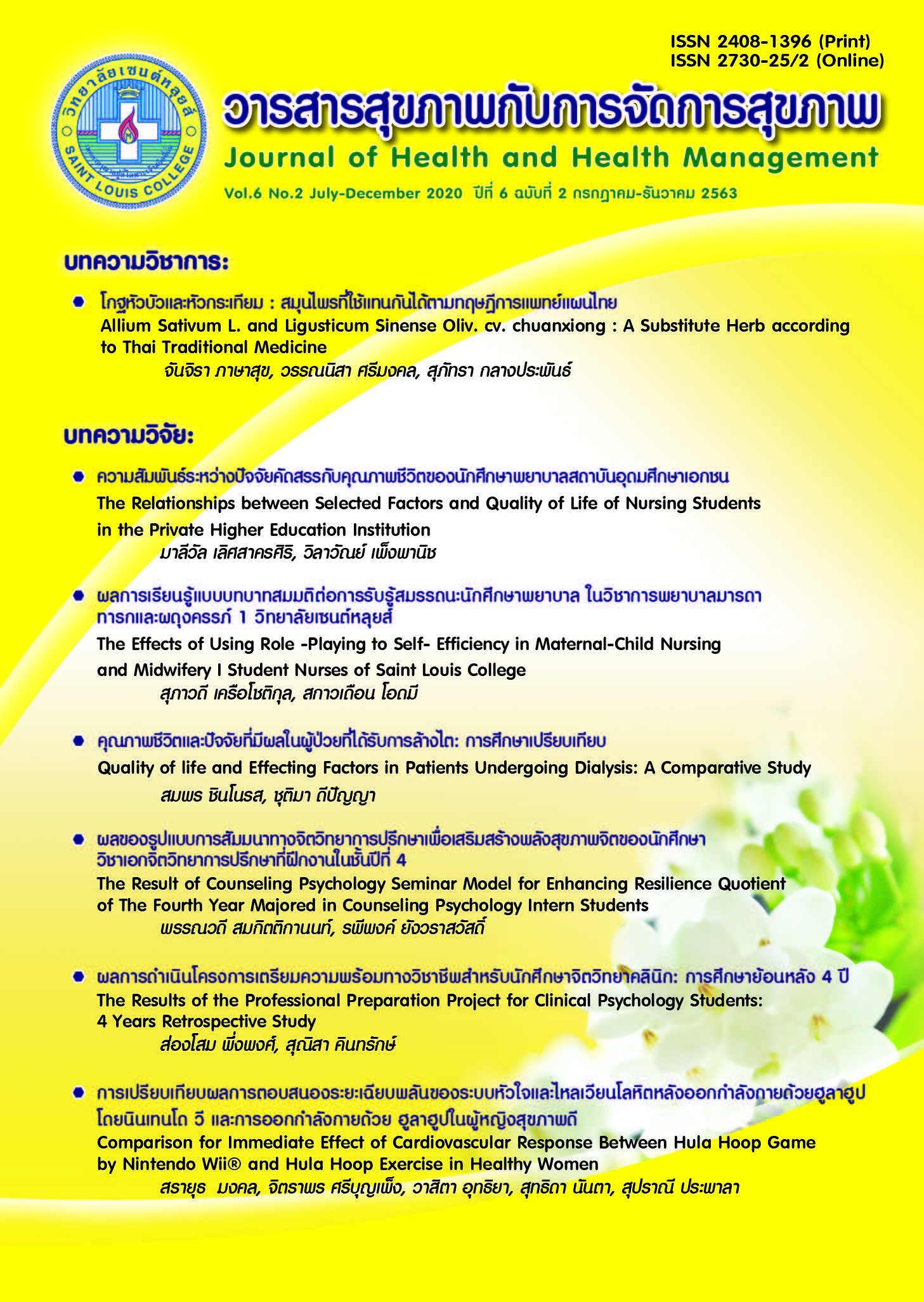The Effects of Using Role -Playing to Self- Efficiency in Maternal-Child Nursing and Midwifery I Student Nurses of Saint Louis College
Keywords:
role -playing, student nurse competencyAbstract
Role playing is an active learning method used to develop learning progress of a learner. This Quasi experimental research design is a One-group Pretest-Posttest research design. The main purpose of this study was to compare self - efficiency of student nurses before and after role –playing in Maternal-Child Nursing and Midwifery I and to study student nurses’ satisfaction towards role – playing in Maternal-Child Nursing and Midwifery I. The population was composed of 140 student nurses who were enrolled in the Maternal- Child Nursing and Midwifery I during the first semester of 2019. The population was divided into 18 groups then simple random sampling was used. Six groups with a total 45 samples were selected. Research instruments were comprised of 1) self-efficacy of student nurses form, developed according to Nursing Qualification Standard of Nursing Council Framework which covers six areas such as Morality and ethics (11 items); knowledge (5 items); intellectual skills (4 items); interpersonal skills and responsibilities (5 items); numerical analysis skills, communication and use of information technology (5 items) and professional skill (9 items) and 2) satisfaction to role playing form. The questionnaire was approved by experts for its content validity. The Index of item Objective Congruence (IOC) was 0.9. The reliability of overall questionnaire, using Cronbach’s alpha coefficient, were .950 and .923 respectively. Data was analyzed by using descriptive statistics and paired t-test.
The results of this study showed that: 1.) The student nurses had mean score of self-efficiency in Maternal-Child Nursing and Midwifery I after role playing higher than before role playing at p-value < .05. 2.) The student nurses were satisfied with overall role playing at the highest level ( = 3.81, SD = .28). Additionally, each aspect found that the learner presented satisfaction at the Highest level. (
= 3.92, SD = .20) and the learning management process at the lowest level. (
= 3.76, SD = .35) It is suggested that role playing method should be provided with feedback collection for each activity to improve learning outcome of nursing students.
References
กรรณิการ์ มีราวุฒิ. (2560). การศึกษาผลสัมฤทธิ์ทางการเรียนและความพึงพอใจในการจัดการเรียนการสอนรายวิชา 0109431 นิทานสุภาษิตจีนโดยใช้บทบาทสมมติของนิสิตหลักสูตรวิชาภาษาจีนชั้นปีที่ 3 มหาวิทยาลัยทักษิณ. วารสารอินทนิลทักษณสาร, 12(3ฉบับพิเศษ), 127-140.
จันทกานต์ ไพรศรี, สรพล จิรสวัสดิ์, และสุขุม เฉลยทรัพย์. (2561). การใช้บทบาทสมมติช่วยพัฒนาทักษะการพูดภาษาอังกฤษของนักเรียนชั้นมัธยมศึกษาปีที่ 5. วารสารบัณฑิตวิทยาลัย มหาวิทยาลัยสวนดุสิต, 14(3), 267-275.
ธานินทร์ ศิลป์จารุ. (2555). การวิจัยและวิเคราะห์ข้อมูลทางสถิติด้วย SPSS และ AMOS (พิมพ์ครั้งที่ 13). กรุงเทพฯ: ห้างหุ้นส่วนสามัญบิสซิเนสอาร์แอนด์ดี
ชฎารัฐ ขวัญนาค, และ สำราญ เลิศคอนสาร. (2562). กิจกรรมการเรียนรู้แบบภาระงานด้วยการสาธิตและแสดงบทบาทสมมุติในรายวิชาสัมมนา ของนักศึกษาระดับปริญญาตรี. วารสารการจัดการเทคโนโลยีสารสนเทศและนวัตกรรม, 6(1), 118-126.
ประกาศกระทรวงศึกษาธิการ เรื่อง มาตรฐานคุณวุฒิระดับปริญญาตรี สาขาพยาบาลศาสตร์ พ.ศ. 2560. (2560). มาตรฐานคุณวุฒิระดับปริญญาตรี สาขาพยาบาลศาสตร์. สืบค้นจาก http://www.mua.go.th/users/tqf
สุพรรณี ชาญประเสริฐ. (2557). Active Learning: การจัดการเรียนรู้ในศตวรรษที่ 21. นิตยสารสถาบันส่งเสริมการสอนวิทยาศาสตร์และเทคโนโลยี, 42(188), 3-6.
สุชาดา ทิพย์มนตรี. (2556). ประสิทธิผลของการใช้การแสดงบทบาทสมมติในการสอน. สงขลา: มหาวิทยาลัยสงขลานครินทร์.
สำนักงานคณะกรรมการการอุดมศึกษา สำนักนโยบายและแผนการอุดมศึกษา. (2561). แผนอุดมศึกษาระยะยาว 20 ปี พ.ศ. 2561 – 2580. กรุงเทพฯ: บริษัท พริกหวานกราฟฟิค จำกัด.
ทิศนา แขมณี. (2558). ศาสตร์การสอน : องค์ความรู้เพื่อการจัดการกระบวนการเรียนรู้ที่มีประสิทธิภาพ (พิมพ์ครั้งที่ 19). กรุงเทพฯ: จุฬาลงกรณ์มหาวิทยาลัย.
วารินท์พร ฟันเฟื่องฟู. (2562). การจัดการเรียนรู้ Active Learning ให้สำเร็จ. วารสารวไลยอลงกรณ์ปริทัศน์ (มนุษยศาสตร์และสังคมศาสตร์), 9(1), 135-145.
Krebt, D. M. (2017). The effectiveness of role play techniques in teaching speaking for EFL college students. Journal of Language Teaching and Research, 8(5), 863-870. Retrieved 27/5/2563 from http://www.academypublication.com/ojs/index.php/jltr/article/view/jltr0805863870
Dorri, S., Farahani, M. A., Maserat, E., & Haghani, H. (2019). Effect of role-playing on learning outcome of nursing students based on the Kirkpatrick evaluation model. Journal of Education and Health Promotion, 8, 197. Retrieved 27/5/2563 from https://www.ncbi.nlm.nih.gov/pmc/articles/PMC6852299/
Sebold, L. F., Boell, J. E. W., Fermo, V. C., Girondi, J. B. R., & Santos, J. L. G. D. (2018). Role -playing: teaching strategy that encourages reflections on nursing care. Revista Brasileira de Enfermagem, 71(6), 2706- 2712.
Suryani, L. (2015). The effectiveness of role play in teaching speaking. ELTIN JOURNAL, Journal of English Language Teaching in Indonesia, 3(2), 106-109.
Vizeshfar, F., Dehghanrad, F., Magharei, M., & Javad Sobhani, S. M. (2016). Effects of Applying Role Playing Approach on Nursing Students ‘Education, Shiraz University of Medical Sciences, Shiraz, Iran. International Journal of Humanities and Cultural Studies. 1772 – 1781. Retrieved 25/6/2563 from https://www.semanticscholar.org/paper/Effects-of-Applying-Role-Playing-Approach-on-Vizeshfar-Dehghanrad/ba52e5ecf19bc7a9cd9d45ff67e19ff6d9139649




